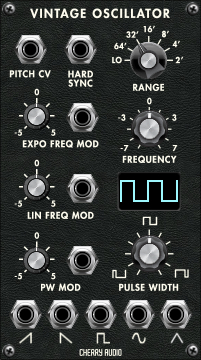The Vintage Oscillator is a fat and warm sounding oscillator that flawlessly replicates the unique waveform discrepancies and minute drift characteristics of coveted classic analog oscillators. It generates all standard synthesis waveforms and features both exponential and linear frequency-modulation inputs.
Inputs, Outputs, and Controls
Pitch CV jack- Accepts a CV input for pitch. Typically this would come from the Pitch jack in the IO Panel CV Out section, or from a sequencer pitch CV out.
Hard Sync jack- Force resets the start of the waveform to the beginning of its cycle. Most often used to create the "sync sweep" oscillator sounds made famous in The Cars' "Let's Go" (or Kraftwerk's "Neon Lights" and No Doubt's "Just A Girl"), by routing the output of a second oscillator to the Hard Sync input and sweeping the pitch of the first oscillator.
Hard Sync is also useful when creating drum and percussion sounds to ensure that the wave starts at the beginning of its cycle.
Range- Sets the basic pitch of the oscillator, displayed in traditional organ footage. LO will be beneath the audible range and allows the oscillator to be used as a mod source.
Expo Freq Mod attenuator and input jack- This jack is used for exponential frequency modulation. This is the "normal" 1V/Oct method used for mapping the pitch of an oscillator across the keys of a keyboard. Positive and negative voltages will raise and lower the pitch of the oscillator in equal musical amounts making this a good choice for creating vibrato or any other low-frequency modulations.
Frequency- Fine-tune control for pitch. This can be used to fatten up multi-oscillator patches by detuning a small amount, or for "building-in" a set interval. Its range is a smidge over a fifth, up or down.
Lin Freq Mod attenuator and input jack- This jack is used for linear frequency-modulation. Linear FM is used for classic FM synthesis where the frequency of an oscillator (referred to as the "carrier") is modulated by another audio-range oscillator called the "modulator." To set this up, patch one of the waveform outputs (typically a sine wave) of another oscillator module to this jack. Patch the Pitch jack from the CV Outs section of the I/O panel to the Keyb CV or Pitch CV input of each oscillator. Now patch one of the waveform outputs of the Vintage Oscillator to the Main Out jacks. Changing the modulator oscillator's frequency and the modulation amount using the Vintage Oscillator's Lin Freq Mod attenuator will give you a wide range of tones from subtle harmonics to harsh buzzy goodness!
To see the difference, try using Exp Freq Mod jack instead of the Lin Freq Mod input. You'll notice that the perceived pitch changes as the modulation amount is increased. In addition to this, the pitch relation between the modulator and carrier oscillators changes as different notes are played on the keyboard making it impossible to tune the oscillator to a traditional chromatic scale. This is exactly why Linear FM is used! Linear FM keeps the pitch relation between the modulator and carrier oscillators intact at different modulation amounts across the whole keyboard.
Pulse Width- This sets the width or "duty-cycle" of the pulse wave. It has no effect on any other waveform. Its default setting of 50% outputs a perfect square wave, rich in delicious odd-order harmonics. Moving the knob left or right narrows its width as well as the thickness of sound until it almost disappears at its extremes, and we’ve included a nifty “faux-OLED” display to indicate the current pulse width.
PWM Amount attenuator and PWM Mod input jack- You may have noticed that moving the Pulse Width knob back and forth creates a nifty sound; instead of wearing out your mouse hand, the PWM Mod input can be used in conjunction with an LFO, envelope generator, or other mod source to continuously vary the pulse width. Best of all, the OLED display looks real cool swooping back and forth.
Waveform Output Jacks- These are output jacks for ramp, sawtooth, pulse, sine, and triangle waves. These can be used simultaneously, in any combination.
